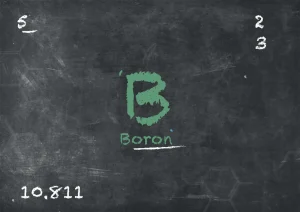
trees now planted
BORON
 What is boron?
What is boron?
Boron, symbolised by B and atomic number 5, is a metalloid element that exhibits properties of both metals and nonmetals. It is relatively rare in the Earth’s crust but holds important roles in various domains.
Pure boron appears as a dark crystalline solid with a high melting point, known for its thermal and electrical insulating properties. Boron compounds find wide-ranging applications in industries such as glass manufacturing, ceramics, and agriculture.
As an essential micronutrient, boron is vital for the growth and maintenance of plants. It is also utilised as a neutron absorber in nuclear power and has uses in the production of specialty alloys and composites.
A 2015 investigation conducted in Washington highlighted the significant metabolic functions of boron. The study affirmed that boron is crucial for bone growth and the proper functioning of the human endocrine system.
In a subsequent investigation focusing on the relationship between boron deficiency and nitrate reduction in tobacco plants, it was found that a deficiency of boron led to the accumulation of hexoses and sucrose in the leaves.
Furthermore, the deficiency resulted in reduced nitrate content as well as decreased levels of magnesium, calcium, and potassium in the leaves. Notably, the reduction in nitrate content was more pronounced compared to the decrease in these cations.
These findings underscore the importance of adequate boron levels in supporting metabolic processes, nutrient uptake, and overall plant health.
Boron is primarily found in borate minerals, which are compounds that contain boron, oxygen, and other elements. Some common borate minerals and compounds where boron naturally occurs include:
- Borax (Sodium Borate): Borax is a borate mineral with the chemical formula Na2B4O7·10H2O. It contains boron, sodium, oxygen, and water molecules. Borax is used in various industrial applications, including cleaning products.
- Colemanite (Calcium Borate): Colemanite is a borate mineral with the formula Ca2B6O11·5H2O. It is another significant source of boron and is often found alongside borax in borate deposits.
- Kernite (Sodium Borate): Kernite is a sodium borate mineral with the chemical formula Na2B4O7·4H2O. It is found in some borate deposits, particularly in arid regions.
- Ulexite (Sodium Calcium Borate): Ulexite is a borate mineral composed of sodium, calcium, boron, and oxygen. It is known for its unique optical properties and is sometimes referred to as "TV rock" due to its ability to transmit images.
- Boric Acid: Boric acid (H3BO3) is a weak acid that contains boron, hydrogen, and oxygen. It is used in various applications, including as an antiseptic and in the manufacture of glass and ceramics.
- Ettringite: Ettringite is a naturally occurring mineral that can contain boron as part of its crystal structure. It is found in some geological formations.
Boron is an essential trace element that plays various roles in the human body, and it may have several potential health benefits. Some of the ways in which boron may be beneficial include:
- Bone Health: Boron is believed to play a role in maintaining bone health by supporting the metabolism of calcium, magnesium, and vitamin D. Adequate boron intake may help reduce the risk of osteoporosis and improve bone density.
- Joint Health: Boron may contribute to joint health by supporting the body's use of calcium and magnesium, which are important for maintaining joint and bone function. Some people take boron supplements for joint discomfort.
- Hormonal Balance: Boron is thought to have a role in regulating hormones, particularly sex hormones like oestrogen and testosterone. Some research suggests that boron supplementation may help balance hormone levels.
- Cognitive Function: There is some evidence to suggest that boron may play a role in cognitive function and brain health. Research in this area is ongoing.
- Wound Healing: Boron may aid in wound healing processes by promoting tissue repair and regeneration.
- Inflammation: Some studies have indicated that boron may have anti-inflammatory properties, which can be beneficial for overall health.
- Metabolism: Boron may influence the metabolism of carbohydrates and fats.


